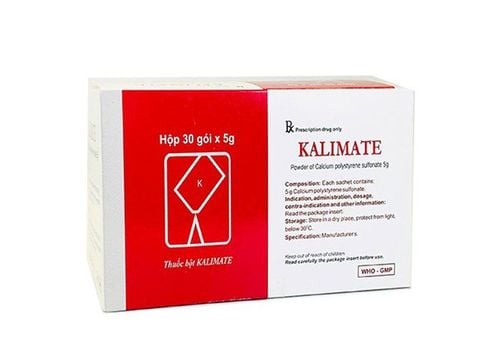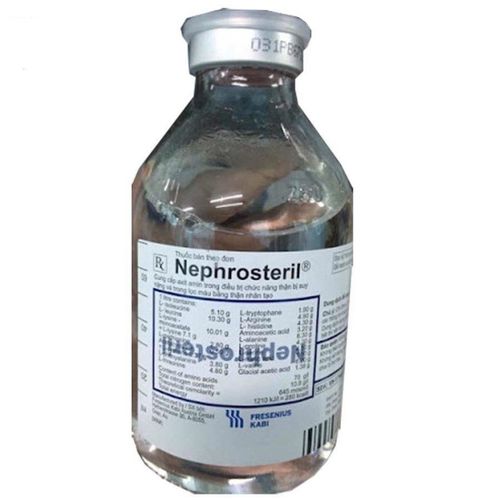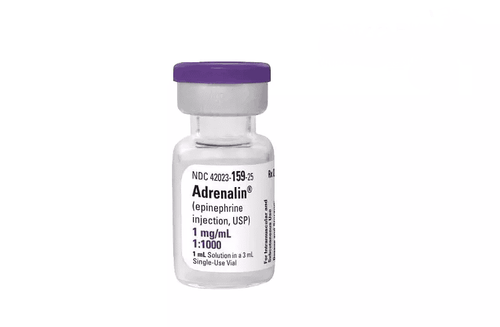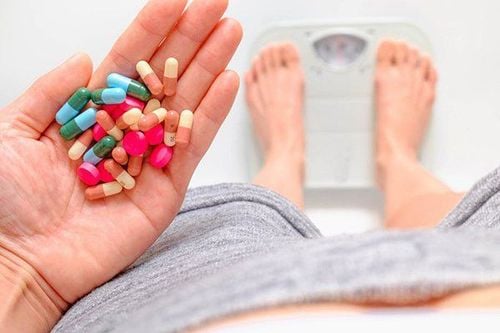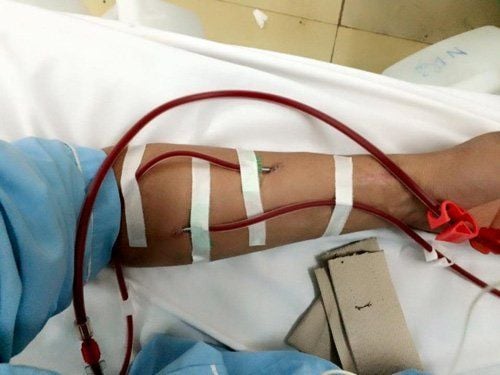This is an automatically translated article.
Post of MSc. Dr. Phan Van Phong - Emergency Doctor - Emergency Resuscitation Department - Vinmec Central Park International General Hospital
Continuous venous-venous dialysis (CVVH) is a dialysis technique that allows the continuous elimination of the patient's blood (>12 hours), water and fecal-weight solutes. less than 50,000 daltons. Especially with the large volume of fluid replacement (≥ 35ml/kg/hour) through the convection mechanism, it helps to eliminate solutes with average molecular weight similar to the weight of proinflammatory substances.
In rhabdomyolysis, there is a phenomenon of destruction of skeletal muscle cells, leading to the release of a large amount of myoglobin into the blood, which will be deposited in the renal tubules, causing tubular obstruction, in addition to increasing uric acid, acid and uric acid. immobilized, causing metabolic acidosis and hyponatremia, causing intracellular edema, hypocalcemia, hyperkalemia easily causing cardiac arrest, high risk of death if not promptly treated.
The above pathological processes take place quickly and continuously, so dialysis measures have proved to be superior to intermittent dialysis measures because they allow continuous elimination of metabolic products due to the process. The above pathology is born but needs to be done soon.
1. Continuous hemodialysis in Acute Rhabdomyolysis 1.1 Indication Severe acute rhabdomyolysis with or without oliguria if 2 or more of the following criteria are present:
Multiple trauma with shock or urine with brown red color (due to myoglobin and after eliminating cause of bleeding) CK enzyme > 15,000 units/liter, not properly diuresis (3ml/kg body weight/hour) within 12 hours. Intermittent hemodialysis (IHD) 4 h/day still carries a risk of death due to hyperkalemia, metabolic acidosis, or strong catabolism (urinemia > 17 mmol/24 h) Excessive fluid overload (edema, weight gain > 10 % dyspnoea) unresponsive to diuretic measures Anuria or oliguria Severe metabolic acidosis (pH < 7.2) Hyperkalemia > 6.5 mmol/L or rapidly elevated potassium rate uremia 1.2 Contraindication Allergy to membranes Hypotension: systolic blood pressure < 90 mmHg
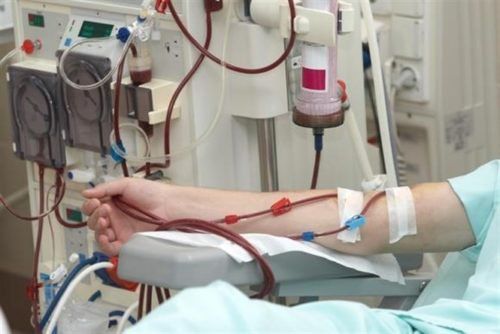
Lọc máu liên tục trong Hội chứng tiêu cơ vân cấp
2. Preparation 2.1 Operator One doctor and 02 nurses for a technical team worked for 8 hours, trained in continuous dialysis techniques.
2.2 Instruments and tools Vital functions to see if the procedure can be performed.
Consumables:
Continuous dialysis tube set Waste fluid bag Bicarbonate or Citrate replacement solution (5 liter bag) Potassium chloride (0.5g/5ml tube) Heparin 25000 UI (5ml) Sodium chloride 0.9% 1000 ml, sodiumbicarbonate 0.14% Calcium Chloride 10% (if the substitute is Citrate) Sterile gloves, examination gloves Medication needle, line Syringes of all kinds 1ml, 5ml, 10ml, 20ml, 50ml N2 gauze Bandage wide Iodine 10% Surgical caps, surgical masks First aid equipment:
Intubation kit Anaphylaxis first aid kit Other amortization costs:
Continuous dialysis machine, warmer, elastic band determination, hemostasis, pins with nodule, no knot, straight scissors, alcohol cotton box, stainless steel bean tray, stainless steel pin holder, sterile hole, surgical gown, Anois solution for quick hand washing, hand soap , white alcohol 900. Install the system of seconds, fruits into the dialysis machine, priming and draining the machine (see also the process of installing seconds, priming and testing the dialysis machine continuously). 2.3 Patient Explain to patient and family members. The patient's head is elevated 30o if there are no contraindications Insert two-catheter inguinal vein or internal jugular vein catheter (see the procedure for central venous catheterization) Ensure breathing and hemodynamics before dialysis 2.4. Medical records Explain the technique to the patient and his family and sign the agreement to consent to the technique.
3. Procedures Check the record: check the indications, contraindications and consent to participate in the technique
Check the patient again: the vital functions can be performed. are not.
Technical implementation:
Connecting and operating the pumps
Connecting the circulatory system of the dialysis machine continuously to the patient's veins through a pre-prepared 2-bore catheter Operating the pumps: + Pumping Blood: in hemodynamically stable cases, start at a rate of 100ml/h and increase every 5 minutes by 20ml until the target rate is reached, in case of hemodynamic instability, start at 60ml/min, increasing every 5 minutes by 20ml until the target rate is reached (note if the blood pressure drops after each increase, wait for the blood pressure to stabilize before increasing again)
+ The replacement fluid pump and the ultrafiltration pump only start operating when the blood pump has reached the target.
+ Target parameters to be set: blood rate 180 - 200 ml/min, fluid replacement rate > 35 ml/kg/min, ultrafiltration rate depending on the patient's excess fluid (0) - 500ml/h)
Use anticoagulation during continuous dialysis (see also the procedure for using anticoagulation in continuous dialysis). Time for dialysis to filter dialysis 1 filter: from 18-22 hours. Criteria for stopping dialysis: depending on each indication for dialysis in a specific situation (see also dialysis procedures for each specific situation). End of dialysis:
Discontinue anticoagulation (if available) 30 minutes before end of dialysis Stop replacement fluid pumps and ultrafiltration Gradually reduce blood rate to 100 ml/hr Return blood to body by connecting suction line Fill the machine with 0.9% sodium chloride solution.

Giải thích về kỹ thuật cho người bệnh, gia đình người bệnh và ký cam kết đồng ý kỹ thuật trước khi lọc máu
4. Monitoring Monitoring during dialysis: monitoring dialysis machine parameters such as blood suction pressure, return blood pressure, TMP transmembrane pressure, and pressure at the beginning and end of the dialyzer every 1 hour; monitor vital signs and balance fluid in and out every 3 hours, weigh the patient once a day; routine tests to monitor dialysis continuously every 6 hours: baseline coagulation, electrolytes, blood count monitoring every 12 hours.
5. Management of complications and complications Bleeding: can be caused by a clotting disorder in the context of an infection or by an overdose of anticoagulants or in combination. Due to anticoagulant overdose, anticoagulant dose should be adjusted and protamine sulfate should be used if necessary. Filter occlusion: often due to inappropriate anticoagulation, anticoagulation dose adjustment and filter replacement if indicated. Electrolyte disorders: strictly follow the routine monitoring and testing procedures to detect electrolyte disturbances for timely adjustment. Hemolysis: due to hemoconcentration, blood flow rate is too high or due to membrane allergy, need to adjust blood flow rate or change another type of filter if due to membrane allergy. Hypothermia: due to the replacement fluid being lower than the temperature of the blood and blood out of the body lost heat. Remedy by warming the replacement fluid and blood before the blood returns to the body. Other complications of infection: infection at the catheter site, at the connections to the devices placed in the blood vessels... Overcome by following the aseptic principles during the procedure and closely monitoring If there are signs of infection, immediately remove the instruments placed in the blood vessels and culture for bacteria when there are signs of infection. Other complications such as: broken filter, clogged filter, overcome by replacing the filter.
Please dial HOTLINE for more information or register for an appointment HERE. Download MyVinmec app to make appointments faster and to manage your bookings easily.
References:
Nguyen Dang Tuan, Nguyen Gia Binh (2008), Review of continuous dialysis technique through 190 times of dialysis at the intensive care unit of Bach Mai hospital, Journal of Clinical Medicine No. 34 , pages 51-56. B.Braun Inc, Continuous Renal Replacement Therapy (CRRT), document for training. Protocol Continuous Renal Replacement Therapy (CRRT) from Intensive Care/Hemodialysis - Unit Practice Manual, John Dempsey Hospital, the university of Conecticut Health Center. Xiaoxi Z, Ping F, continuous replacement therapy (CRRT) for rhabdomyolysis, Cochrane Renal Group, doi: 10.1002/14651858.CD008566.




